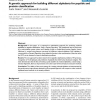Free Online Productivity Tools
i2Speak
i2Symbol
i2OCR
iTex2Img
iWeb2Print
iWeb2Shot
i2Type
iPdf2Split
iPdf2Merge
i2Bopomofo
i2Arabic
i2Style
i2Image
i2PDF
iLatex2Rtf
Sci2ools
105
Voted
BMCBI
2008
2008
A genetic approach for building different alphabets for peptide and protein classification
Background: In this paper, it is proposed an optimization approach for producing reduced alphabets for peptide classification, using a Genetic Algorithm. The classification task is performed by a multi-classifier system where each classifier (Linear or Radial Basis function Support Vector Machines) is trained using features extracted by different reduced alphabets. Each alphabet is constructed by a Genetic Algorithm whose objective function is the maximization of the area under the ROC-curve obtained in several classification problems. Results: The new approach has been tested in three peptide classification problems: HIV-protease, recognition of T-cell epitopes and prediction of peptides that bind human leukocyte antigens. The tests demonstrate that the idea of training a pool classifiers by reduced alphabets, created using a Genetic Algorithm, allows an improvement over other state-of-the-art feature extraction methods. Conclusion: The validity of the novel strategy for creating red...
| Added | 09 Dec 2010 |
| Updated | 09 Dec 2010 |
| Type | Journal |
| Year | 2008 |
| Where | BMCBI |
| Authors | Loris Nanni, Alessandra Lumini |
Comments (0)

